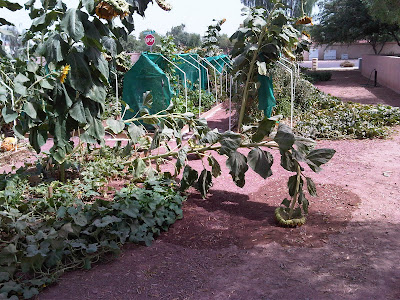Home grown makes for a happy family.
Saturday, July 30, 2011
Friday, July 29, 2011
A Praying Mantis
The praying mantis is named for its prominent front legs, which are bent and held together at an angle that suggests the position of prayer.
Thursday, July 28, 2011
Tempe Community Action Agency
At the end of our recent work day I made a run to Tempe Community Action Agency's Food Pantry to share the bounty harvested by the volunteers that morning.

Community Action works in Arizona. See here for video.
Wednesday, July 27, 2011
Being a Locavore and more
Last week a dozen or so FIGG members convened at the Hardesty house, laden down with home-made, even home-grown goodies, bottles of wine and dog-eared copies of “Animal, Vegetable, Miracle” by Barbara Kingsolver http://www.animalvegetablemiracle.com/. A fine evening of feasting, laughing, catching up, a little discussion of the book and its effect on our own lives followed.
For those who couldn’t make the event and haven’t read the book, it’s the tale of a family’s year of eating only local, seasonal food from their own garden and the local community at a time when the term “locavore” was barely coined. The benefits of this way of eating include reducing the distance food travels, obviously, which uses less oil. It also encourages organic and pesticide free growing, and local produce can be grown for taste and not ease of transport, keeping alive heritage breeds and heirloom varieties. Keeping food dollars local strengthens the local community and supports small growers and farmers. Growing, cooking, and eating as a family also nurtures the family bond, and the book resounds with this family joy, despite the evident occasional hardships.
We all agreed it’s a lovely thought, and many of us relish the idea of such self sufficiency. But the reality is that we live in a huge urban center in the middle of the desert, and rural bliss is not in our immediate future. The discussion quickly turned to what we can do, individually and collectively in our own lives to foster these ideas.
Firstly, starting a garden is the best start, so FIGG members are way up there, not only growing their own organic, doesn’t get any more local than this produce. But in Phoenix our seasons are short, gardens require plenty of water; another precious resource, and most of us don’t have the land, time or energy to approach anything like self-sufficiency. We did discuss changing more home landscaping to edibles, practicing more water conservation at home to divert the resource to growing food, and the popularity of backyard chickens. (I have a flock, and recommend them highly).
A fabulous next step is to consciously think about where our purchased food comes from. Support our local farmers and growers by shopping at a farmers market, and understand that they are charging the real cost of quality produce and meat. We were reminded that our local market at McClintock and Warner is running every Saturday from 7-11 am, and the growers need our support. Pastured, grass fed beef and lamb can be bought from the market, or ordered in bulk direct from a farmer at a much better price. Several local farmers only butcher in September, so now is the time to put in that order for a lamb or part of a cow. When shopping at a regular store, think local! Basha’s is locally owned, and makes a big effort to sell AZ grown produce. Read labels, and ask where your produce is from. If it’s not marked, or there’s nothing local, mention it to the produce manager. Make the best choices you can – is it better to buy organic apples from New Zealand or conventionally grown from Washington State? I was recently shocked to see that the organic, grass fed beef I had bought from Sprouts was imported from Uruguay!
~ Isabel Hardesty
Tuesday, July 26, 2011
Monday, July 25, 2011
Work Day at the Garden
A little cleanup fun with a chipper/shredder that breaks down any stalky, woody stuff on site.

And fun was had by all.
Saturday, July 23, 2011
Thursday, July 21, 2011
When to Harvest Garlic
TIMING IS EVERYTHING, THEY SAY, AND WITH GARLIC HARVEST that’s especially true. But since the crop is hidden underground, how do you know when this edible Allium is ready—when it’s just the right moment to insure a well-formed head that will also store well through the winter and beyond? Like fortune-telling, it’s all in reading the leaves, apparently.
For more information go here.
Wednesday, July 20, 2011
Summerize
If you aren’t jazzed about working your plot in the heat, then it is time to summarize all or a portion of it.
How to summarize:
- Dig you plants back into your soil (the big stalks can go in the city trash can.
- Cover the bed with 4" compost.
- Cover the compost with a layer of straw.
- Leave it until fall when you can scrape the straw back and dig in the compost.
- While the soil is resting, microbes are busy at work improving your soil for the next planting season.
- Reduce the amount of water and also the frequency (soil should be kept barely moist).
Tuesday, July 19, 2011
Animal, Vegetable, Miracle. A Year of Food Life
Tomorrow is the get together where food will be served and things learned from this book discussed. Are you coming?
Sunday, July 17, 2011
Friday, July 15, 2011
Wednesday, July 13, 2011
Friday, July 8, 2011
More bugs
They are squash bugs. These are only baby ones, they do get bigger. They are pretty ugly little bugs and they can ruin your plants. There doesn't seem to be a lot you can do about them except that neem oil can kill the babies and the eggs but not the adults.
Thursday, July 7, 2011
Wednesday, July 6, 2011
Monday, July 4, 2011
Subscribe to:
Posts (Atom)
















































